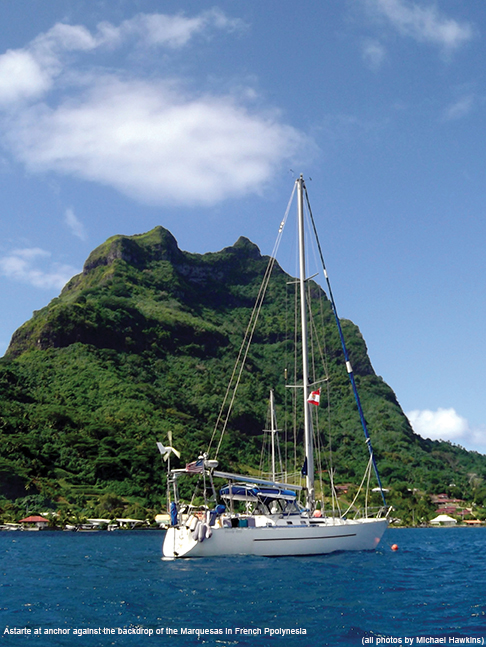Lessons learned from an experienced cruising couple (published October 2014)
There is some celebrating aboard Astarte, our Moody 422. We toast two milestones: five years aboard and 25,000 miles under the keel. It is an occasion for reflection as well as celebration of that half decade of “living the dream.” It was a dream we had for many decades before we untied the dock lines on February 9, 2009 from St. Petersburg, Florida. Now, heading back south from the Marshall Islands, it’s time to look back at those years afloat.
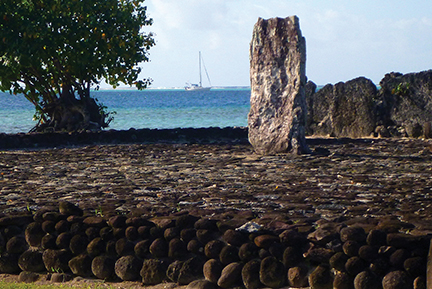
The Marshall Islands stamped our passports and became country number 28 over the past five years. The number of different islands or anchorages where we’ve dropped the hook is well over 150 spots. We’ve been full time cruisers ever since, leaving the boat only for short periods of time to head back for important occasions: a wedding, a funeral and mom’s 90th birthday!
On Astarte we have discovered that, simply put, the highs are higher and the lows are lower. Aboard our floating home, everything is a bit more exaggerated than on land or even at the dock. When things are great, they truly are magnificent. But when things are bad, there is no escape. The good thing is that in five years of blue water sailing, the good has outweighed the bad…by a lot. For those thinking of untying the dock lines and getting the passport stamped, here are some discoveries about the cruising lifestyle we’ve made with the help of many other cruisers and locals along the way.
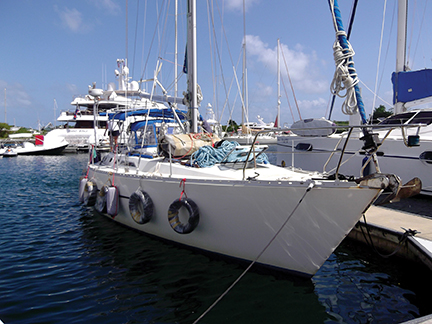
GETTING ALONG ABOARD
This is probably the most critical piece of the puzzle to make cruising a successful way of life. Unless you’re a mega-yacht, the cruising boat is a small space and when offshore, there really is no escape. Over five years, we’ve learned a great deal about each other and ourselves. The good news is that we got along great on shore, so the move on board simply required some modifications to our solid relationship. Personal space and time was, and remains, the biggest challenge. You need to give yourself and your cruising partner some of both. Aboard Astarte, we each have our favorite places to read, write or simply contemplate the world. We also try to respect each other’s time for peace and quiet.
The division of labor is also something that needs to be settled on, preferably before you leave the dock. We each have responsibilities and we have shared jobs. They tend to fall along the lines of skill sets as well as interest levels. For example, Michael does all the engine work as well as the sewing. Though I’ve taken a diesel maintenance course, I really have no desire or interest to change the oil. And I can’t sew a stitch. I’m happy to provision and cook. It’s my creative outlet. I wasn’t much of a baker on shore, but I’ve come to enjoy creating something new, often without a recipe. When it comes to cleaning, that’s a shared chore. We both hate it and yet it needs to be done. So, we share it.
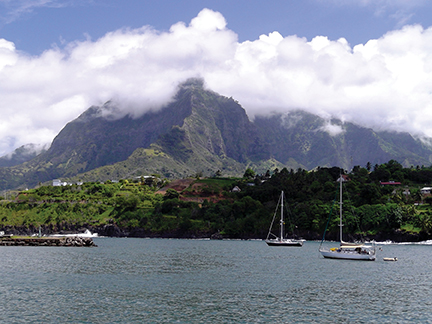
Shared interests in activities also make for a happier cruising couple. We both are certified divers, though now we tend to snorkel more than dive. We really enjoy being in the water and looking at sea critters. Obviously, we both like to sail and have honed our sailing abilities with the help of lots of expert cruising sailors out here. We like to “catch” more than we enjoy fishing, but it just seems you can’t do one without the other. And we both have similar styles with regards to how we visit and interact with locals and explore the islands.
When we get mad at each other we try to talk it out and solve the problem. We work hard at not making anything linger long—it can escalate on a boat too quickly. We’ve been together long enough that we know each other pretty well. Neither of us are screamers and that helps. Plus, there’s always the dinghy—and both people should be 110 percent comfortable running it—for an escape and walk ashore.
The other thing we did before leaving was to agree on an “out.” On our first cruising experience in 2001, we promised to stay out at least three months before calling it quits to give it a good chance. It worked. This time out, we have agreed in advance that whenever it ceases to be enjoyable for either one of us, we’ll call it quits without holding a grudge against the other.
We’re still happily married and still cruising—a toast!
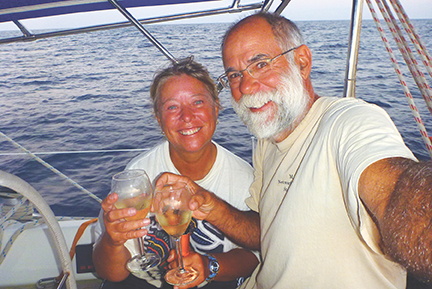
PEOPLE EAT EVERYWHERE
Don’t worry about provisioning the boat for five years, because people do eat everywhere. You may not find your favorite marinated artichoke hearts, but you will find staples and fish in just about every country. We’ve found that part of the real joy of the cruising lifestyle is trying the local food wherever we are. So at the local produce markets, simply ask, “what’s that?” and the follow-up, “how do I cook it?’ You’ll expand your food loving horizons and make new friends along the way. If you have food allergies or really crave some particulars, you better load up.
The other valuable provisioning lesson we’ve learned is: if you see it, buy it. Once we waited to get eggs on our way back from a walk because we didn’t want to carry them. After an hour, they were all gone and wouldn’t be re-supplied for weeks. Don’t ever count on something being there in an hour or a day. If you want it, get it.
We’ve eaten well aboard Astarte on passages and at anchor—a toast!
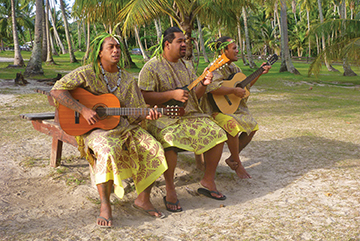
FIXING THINGS
Our definition of cruising has been, “fixing your boat in exotic locations.” One of the most critical skills aboard a cruising boat is the ability to fix a variety of things without a nearby marine or big box store filled with parts. Whether it’s the head or the windlass; the diesel engine or the watermaker; the bimini or the coffee pot, you’ll need a good sense about fixing things.
We carry a lot of spares. Spare nuts and bolts of various sizes fill containers. O-rings are o’plenty. Stainless hose clamps and lengths of hoses have homes aboard. Plus there are lots of very specific parts for all the major systems like electrical, outboard, watermaker and propane systems. The diesel engine has a whole locker filled with spares, filters and oil. Michael is also a maintenance maniac. The oil is changed when that hour meter hits the magic number and the watermaker filters get changed before they get too ugly.
Before every major passage we go through a list of things to check, from going up the mast to looking at the rigging, to tightening all the screws on the cockpit bimini. The sails get a good look before and after passages, and stitching or patches are made. The nav lights get fired up, as do all the electronics that haven’t been run. The steering system gets a good review as well (lesson learned in the passage from Tonga to New Zealand).
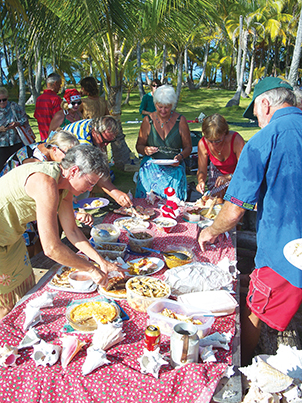
We have also timed the major maintenance projects, like bottom jobs, for when we would be in countries that could handle hauling the boat. We did a job in Honduras, Panama and New Zealand. They were all great experiences, but took advanced planning. Before you make the call to haul out, you want to find out about the products you’ll need like paint, through-hulls or cutlass bearings. Places can usually haul you, but getting the bit that needs replacing may create a costly wait in the yard for shipping or be impossible to get or fix.
To my mechanical man—a toast!
FOREIGN LANDS & THEIR PEOPLE
This is the reason to go cruising. You have a boat to get to places that others cannot. Many of the islands we’ve had the honor of visiting have no airport, nor cruise ship dock. You get to remote places that have not yet been spoiled by too many tourists. You get to see real life by real people living an island existence. We have been welcomed into communities and shared in festivities and celebrations. It is the reward of a cruising lifestyle.
You do have to learn to appreciate the local customs and sensibilities where you go so you don’t offend your host islands. Most of the islanders are simply too polite to say anything to you. It’s always a good idea to know a little before you go and help from other cruisers and cruising guides will allow you to negotiate this courtesy.
Our rule aboard Astarte has always been to respect the country we visit from doing all the legal and right things when clearing in and out, including being appropriately dressed to meeting with officials. Plus, we try hard to learn a few phrases in the local languages including hello, how are you and thank you.
Another toast to the many people and places we’ve enjoyed!

THE FLORA & FAUNA
Besides the remarkable and interesting people abroad, there is also the thrill of seeing the fascinating creatures and plants of the various places. The list of critters we’ve spotted in the wild continues to grow. Monkeys of various breeds, bats in caves and flying foxes in trees, colorful, but poisonous frogs, reptiles of all sorts, insects large and small, butterflies galore, playful penguins and seals, and magnificent birds of strange colors and habits. Creatures that are indigenous to remote islands are particularly exciting to spot. Add to all these creatures the wonderful and unusual plants, trees and flowers. Being avid snorkelers and divers we’ve also been thrilled at seeing underwater life including swimming with giant manta rays, diving with thousands of sharks of various types, and seeing colorful underwater tropical fish and creatures large and small.
To all the things in the wild—salute!
THE CRUISING COMMUNITY
You may have given up your neighborhood or work colleagues, but now you have a whole new group of friends. The cruising community is just that, a community. People are always willing to help each other and share everything from information to spare parts to sundowners. Because you all have boating and cruising in common, there is an instant connection. We’re all in this together out here. The best part is that this community is not as homogenous as many neighborhoods or workplaces, you have a wonderful mix of people from all nations, with varied backgrounds and experiences. People that you would probably never meet in your shore side experiences may become your new best friends and your life will be richer for it.

A toast to all our new friends aboard too many vessels to name—you’ve made our life aboard so much more fun. Cheers!
LIVING WITHIN YOUR BUDGET
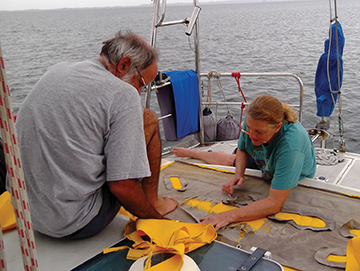
You should know what your budget is before you go cruising. The lifestyle can be extraordinarily inexpensive if you so choose or you can live life on the extravagant side. But you should know what you can afford based on the number of years you want to spend out here. Be prepared for some unanticipated boat repairs or having to ship a part into a foreign port, which can sometimes be very expensive. We’ve spent less on food than we budgeted, less on fuel (we actually sail more), and, by choice, we rarely stay in marinas or on moorings because they eat up the cruising budget quickly. We are spending more on Internet access, and clearance costs into countries seem to be going up each year. Boat maintenance like bottom paint jobs have been cheaper in some places than back in our home country, but acquiring parts can be costly. We have not done much inland travel, which is enjoyable, but can eat into a budget—this is something we’ve regretted a few times.
We have also not traveled back to the States very often, as the ticket prices are high. If visiting the children or grandchildren is important to you, you’ll have to budget accordingly. Skype is a blessing to the cruising sailor when you have a speedy enough Internet connection. We also do extensive research and will sometimes skip a country if the check-in/out fees are too exorbitant. We enjoy cook’s night off by going out for a meal, but limit the restaurants to local spots and often dine out at lunch rather than dinner. We do celebrate the big occasions like birthdays, anniversaries and equator crossings. The bottom line is simply to know your own bottom line and try to stick to it. We’ve known cruisers who do live very inexpensively and others who spend like they are printing money. We’ve learned what our credit card can bear and when we have a big, unexpected expense, we cut back where we can. We also track every dollar spent so we know where the money is going.
Cheers (with beer instead of champagne because we’re on a budget) to sailing within our means!
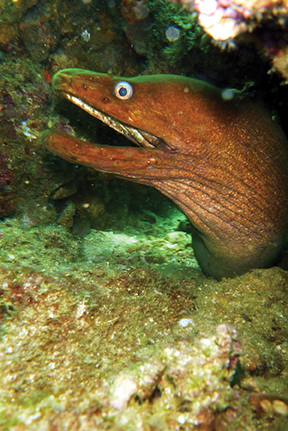 MOTHER NATURE RULES
MOTHER NATURE RULES
We tell visitors to pick a time or a place, but they can’t pick both. We have learned that we shouldn’t make hard and fast plans to be in a new location by any certain date. Mother Nature does rule. Weather is the ultimate decision maker for safer passages and for specific anchorages. You don’t want to be on a lee shore in a big blow, nor do you want to be making that overnight hop in a low pressure low. We won’t put ourselves or boat at risk simply because we promised someone we’d meet them. We know when and where we need to be for cyclone/hurricane seasons and we get there well before the deadline. Don’t get me wrong, we’ve certainly seen our share of crappy weather on both passages and in anchorages, because it is, after all, the weather and changes constantly.
We’ve learned to get weather information from reliable sources and we get it often. We are avid fans of the SSB radio and the weather products available through SailDocs via sailmail and winlink. We’re not pros, but we make the best guesses we can with the most information we can get. The hardest decisions we make are multiday passage decisions—do we go or not go? Weather is hard enough to predict for the next day, but when you are trying to look longer term over a longer distance, it can make you crazy. But the old adage, “look before you leap” is fitting for getting lots of weather info before heading out.
We survived the big “squash zone” between Tonga and New Zealand—a toast to Mother Nature!
TAKE CARE OF THE BOAT & SHE’LL TAKE CARE OF YOU
If you have a seaworthy craft, trust it and take care of it. We have been scared on board many a time. Whether hove to, underway or at anchor, we learned that the boat will take care of us. But that means fixing broken parts, keeping the engine in good working order, making sure the sails aren’t torn or seams tearing, and keeping the leaks down and the bilge pumps working. It’s hard work, but it does pay off when you need the boat to perform.
To the good ship Astarte—cheers!
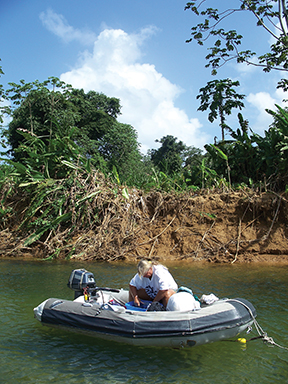
STAYING HEALTHY
This is, like weather, something you can’t predict. But after five years aboard, we are both healthier than when we left. The temptations of fast food are gone. A boat, by its nature, keeps you moving. We may dinghy to shore, but once ashore we walk just about everywhere. We swim and snorkel a lot. We are more active, eating healthier and as a result, are happier. The other good news is that many countries have very good health care when it is available. We’ve had our teeth cleaned in Colombia, Panama and Fiji. Routine prescriptions have been filled easily and there are lots of cruisers out here in the medical profession to give advice. We have a nicely stocked first aid kit and have been lucky to have to give away more to small island clinics than use it.
We have been exceedingly lucky to not have any mishaps or major illnesses in the five years—for that, a double toast!
PIRATES!
Haven’t met any, unless you want to consider the cab drivers in a few countries! Safety at sea is the first question we are always asked. We have not met any pirates and hope not to in the future. We avoid places that other cruisers have reported as dangerous. On shore, like in any country, we avoid the areas you shouldn’t go, especially after dark. But other than one instance in Colon, Panama, we have been safe aboard and on shore. We lock up our boat and dinghy in places you need to do so. We are careful with our surroundings but we’ve also participated fully in celebrations in cities, towns and on islands. We consider ourselves careful but we also try hard not to miss out on the fun.
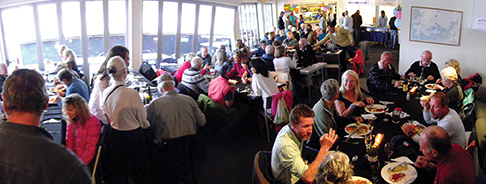
Another toast to staying safe!
Years pass. Your passport gets stamped. You put up your courtesy flags. You drop and set your anchor countless times. Miles swim under your keel, and you swim miles in the sea. Parts break. You fix your boat in exotic locations. You meet people from new countries, different islands and other boats. You learn to say Talofa, Bula, Buenas Dias, Iakwe, Maori and “hello” in various languages. You see traditional dancing, singing and sporting events. You try new foods. You explore new cultures and see wonderful natural sights. The sunsets are still glorious—with or without a green flash. The star-filled nights on a passage are unbelievably bright. It’s a great lifestyle and you continue to grow and learn new things about the world, your partner and yourself. The lows may be lower, but the highs are certainly higher. And there are more of them.
Five years and still counting—cheers from Astarte!
After careers in the television business, Barbara and Michael are now living without a TV aboard Astarte, their Moody 422. Now they spend their time exploring and fixing the boat in exotic locations. Barbara has been published in numerous magazines, guides and international newspapers and Michael is still shooting a camera (still photos now!) above the ground and under water.
















